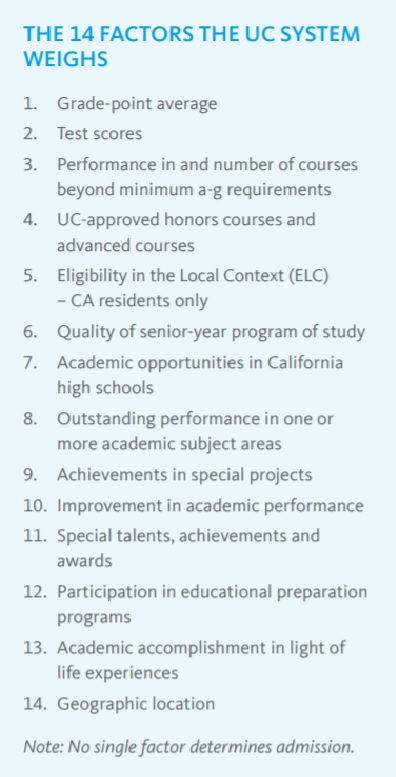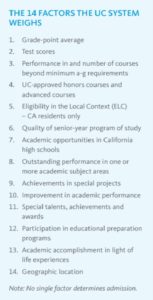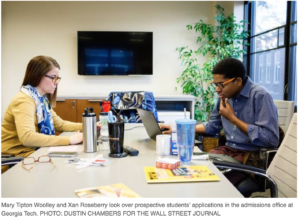Did you know that University of California system has a 14 point admission Criteria? Here is the comprehensive list:
http://admission.universityofcalifornia.edu/freshman/how-applications-reviewed/

Cultivate skills and interests to demonstrate a unique talent.LEARN MORE
Achieve your Dreams
by collegematch

Did you know that University of California system has a 14 point admission Criteria? Here is the comprehensive list:
http://admission.universityofcalifornia.edu/freshman/how-applications-reviewed/

by collegematch
Goal: To make sure your child’s hard work and achievements get the validation they deserve.
Instructions:
1. Once your child has started developing in areas of leadership, service entrepreneurship, performance, art, writing, research, scholarships, or academic competition or scholarship, discuss ways that achievements can be used to:
• Raise awareness for a worthy cause
• Build community
• Inspire or educate others
2. Explore avenues for achievements to get profiled, reviewed, or published through print, television, online media, or social media.
3. If your child gains recognition at the local level for good work, scale the recognition upwards to the state, regional, national, and even international level.
You can find this exercise on p. 59 in BRAND U: 4 Steps To The College of Your Dreams.
by collegematch

Article by By Melissa Korn – WSJ

With so many applying, fewer schools have one person read a whole application; plowing through 500 files in a day
As application numbers surge, admissions officers at some elite colleges say they don’t have time to read an entire file.
Instead, staffers from more schools—including the Georgia Institute of Technology, Rice University and Bucknell University in Pennsylvania—now divvy up individual applications. One person might review transcripts, test scores and counselor recommendations, while the other handles extracurricular activities and essays.
They read through their portions simultaneously, discuss their impressions about a candidate’s qualifications, flag some for admission or rejection, and move on. While their decision isn’t always final, in many cases theirs are the last eyes to look at the application itself.
The entire process can take less than eight minutes.
____________________________________
Do:
• Keep essays focused and personal
• Highlight extracurricular activities that really mattered to you
• Tell a coherent story across essays, transcript and activities
Don’t:
• Use acronyms that only people familiar with your school would understand
• Assume the reader knows nothing about where you grew up
____________________________________
The new approach puts students at a disadvantage because an admission officer doesn’t get a comprehensive view of the candidate, some high-school guidance counselors say.
“If they’re splitting it up, it’s not holistic. Nobody has a full feeling” of the applicant, said Chris Reeves, a school counselor at Beechwood High School in Fort Mitchell, Ky., and a director at the National Association for College Admission Counseling.
“I put in four years of super hard work. To know that it’s all over in 10 minutes is just mind-blowing,” said Caleb Richmond, an 18-year-old senior at the Derryfield School in Manchester, N.H., who says he wrote about seven drafts of his main college admission essay.

Committee-based evaluation, which involves a committee of two people, is the admission industry’s answer to ballooning application volume. Admissions directors say it is better for staffers than spending solitary months reading essays, transcripts and recommendation letters. They also say it helps train new readers and minimizes bias by forcing readers to defend why they think a candidate is qualified or not, and as a result they’re more confident in the decisions the new committees are making.
Admissions officers estimate that upward of 30 elite schools have embraced the method, championed early by the University of Pennsylvania. Colorado College, Case Western Reserve University, Swarthmore College and the California Institute of Technology use variations as well.
Schools say they are making the shift in part to stem staff turnover, as many now quit at the end of the reading season. “It’s a more humane way of reviewing applications,” said Marylyn Scott, senior associate dean of admissions at Bucknell. The school adopted the approach during the last admission cycle.
Readers at Bucknell, which gets more than 10,000 applications, used to take 12 to 15 minutes to review each application. Now a team of two is done in six to eight minutes.

Combined, Ms. Scott noted, that is still up to 16 “person minutes.”
Last year, the school admitted about 3,200 students and enrolled just shy of 1,000.
A three-person committee reviews the team’s notes before making a final call.
Efficiency is crucial, since more students are using the Common Application, which allows them to submit material to multiple schools. Nearly 902,000 students used it last year. As of Jan. 15 this year, the number was already 898,000 students submitting to an average of 4.8 schools.
Applications to Georgia Tech jumped by 13% for the coming academic year, to 35,600. The current freshman class has roughly 2,800 students.
“There’s just no way we could have gotten things done” without significant strain, said Rick Clark, director of undergraduate admissions.
That school introduced committee-based reading in the fall, and the staff, in up to 12 teams of two, now plows through about 500 applications a day.
The officer in charge of a particular region, referred to as the driver in the process, opens a file online and describes the applicant’s school to his or her partner, the passenger. The driver looks over an applicant’s academic transcript and test scores, while the passenger takes on counselor recommendations, essays and extracurricular activities.
They make a decision after eight to 10 minutes: admit, deny, waitlist. In about 85% of the cases, the application isn’t reviewed again.
“I’ve legitimately read—not skimmed, but read—more counselor recommendations in the last round than I have in the last three years,” Mr. Clark said. “I have time to read them.”
Critics say a fragmented reading provides little insight into candidates’ nuanced applications, and rather than reducing bias the team-based process can lead readers to reinforce one another’s assumptions.
Jim Conroy, chairman of the post high school counseling department at New Trier High School in Winnetka, Ill., says he spends years teaching colleges’ territory managers about his high school. Now, though, “There’s no context to their reading.”
Colleges say the committee would likely include the regional representative who knows about a school’s academic rigor and extracurricular offerings.
Still, some schools want to do things even faster.
Yvonne Romero da Silva, formerly at Penn and now vice president for enrollment at Rice, is focused on shaving a few more seconds off the process by reducing the number of text boxes into which readers can add notes and streamlining drop-down menus.
“Little things like that, after 40 files, really add up into concrete minutes,” she said, adding that the main goal is to spend that time on reading more closely.
Mr. Richmond, the senior from New Hampshire, agonized over his essay, about coming to terms with being gay.
“I can’t even tell you how many hours I stared at the page, just thinking about word choice, what I wanted the sentence to sound like,” said Mr. Richmond, who was accepted early to Swarthmore.
Then again, he said, “The process worked for me.”
Corrections & Amplifications
A photo above shows Mary Tipton Woolley and Xan Roseberry in the admissions office at Georgia Tech. An earlier version of the caption incorrectly gave their names as Mary-Tipton Woolley and Xan Rosenberry, and it incorrectly said the office is in the Georgia Tech Admissions Building. Separately, an earlier version of another photo caption incorrectly gave Rick Clark’s first name as Rich. (Jan. 31)
Appeared in the February 1, 2018, print edition as ‘Top Colleges Speed Read Applications How To Stand Out In Eight Minutes.’
…
by collegematch

Think Like A College Admissions Officer
Develop Uniqueness
You’re an admissions officer at a major university. For three very intense months, you spend somewhere between six and twelve hours each day reading applications — hundreds of them — from nice, well-meaning kids, and you have somewhere between 10 and 20 minutes to decide their fate.
In that time, you have to figure out who the student is, what makes her special, and what unique value she can offer the university. Unfortunately, as you flip through the files, you find the same molds repeating themselves, an endless succession of honors students and varsity athletes, math club members and science team leaders, all with good track records, but with little to help you distinguish what’s special.
Your vision blurs. You yawn, stretch, and toss another file into the 50/50 pile. You reach for another, wondering how much more you can take, when suddenly, you wake from your stupor, reading about a student with unique promise—an unusual combination of passion and talent who has constructed a rock-solid picture of who she is, what she loves, and what she wants out of life. Her unique experience will add value to your university in ways that no other student can, and her knowledge about your school proves how vested she is in creating her future. You feel a tingling, a thrill of pride as you place her in the acceptance pile, giving her a springboard into a promising future.
It’s moments like these that make the job worthwhile.
To learn the never before revealed 12 steps that will make your application unique, download both of David Montesano’s Brand U books, 4 Steps, and Stand Out to Get In.
by collegematch

BUILDING VALUE TAKES time, usually a couple of years, so if possible, we recommend getting started early in high school, sophomore or even freshman year for your college admissions endeavor.
Once the fire of strong talents and interests gets lit, there’s no reason to stop. Building confidence and esteem to high levels assures that your student will:
• Have a clear vision and purpose for the future to guide his college selection
• Convey her story with pride and excitement on her applications
• Head into college with strength and momentum
We have found in our work with young people that when they fuel their sparks in their deepest ambitions, they consistently exceed their wildest expectations. Potential has no limitations, and the discovery of this fact is an integral part of the Brand U process that we call Scaling Upwards.
By Scaling Upwards, students take their skills and passions as far as they possibly can.
Scaling Upwards puts the defining touches on your child’s accomplishments, allowing personal goals and achievements to build on themselves:
• If your student has completed a research project or won a competition or scholarship, these accomplishments can be used to raise awareness and bring a positive message through media recognition.
• If your student has created art or writing or has performed at a local level, that success can be used to build community support to push the accomplishments into state, national, and even international forums.
• If your student has started a business, nonprofit, club, or community program, that achievement can be expanded and replicated in locations beyond the local level.
scaling upwards: third-party recognition.
In the ultra-competitive arena of college admissions, third-party recognition validates your student’s ambition and purpose by profiling achievement in ways that colleges can see.
It’s great if a student starts a nonprofit, but if that nonprofit gets written up in a newspaper or garners a positive quote from a mayor or civic leader, that achievement is suddenly awarded far more weight and importance. Likewise, if a young person forms an acting group that stages a play, that’s great, but that achievement will be far greater if it’s written up in the local paper.
Third-party recognition is a primary method for scaling upwards, and it’s not as hard as it looks. With so many negative stories always swirling around, media outlets—from local papers and TV news to online media—are hungry for positive stories about young people taking initiative and making a difference.
Recognition can take any number of forms:
• Getting a research paper or journalistic piece published
• Getting pro led by TV news or newspaper for academic and
extracurricular successes.
• Winning a science project, or getting one’s name in the
newspaper for starting a community service.
• Superlative comments from teachers for academic success
• Positive recognition from leadership gures
For college admissions, third-party recognition will make your student a “triple threat” in the eyes of admissions reps, taking the ambition and achievement and providing the substantiation they deserve. Remember, admissions officers only have fifteen minutes to learn who your student is. When colleges see that your student’s hard work has been validated in this way, they’ll fling their doors open.
I’m passionate about this point because it works every time. ird- party recognition ensures that your child’s hard work stands out from the thousands of other applicants to make sure that their theme of value is clearly positioned in the minds of admission officers.
Sharon from Belmont, Massachusetts
Sparks: Love of computers, commitment, teamwork
Harnessing Fire: Third-party recognition
When we met Sharon as a sophomore, she spoke of her interests in computer science and engineering. Working with her parents, we explored ways that she could develop leadership skills in the field. During her sophomore year, she began pursuing opportunities through tech clubs and science fairs, and got involved in her school’s Robotics Team. By her junior year, she’d earned the respect of her teammates and was chosen to lead the team. Dedicating herself to her passion, she coached her team in the invention of a brand new prototype robot, and earned a series of victories in science contests at the state, national, and ultimately international level.
Her achievement yielded her a story in a national magazine article celebrating youth in science, and her work garnered further recognition through a national “Women in the Sciences” award. She also earned a prestigious scholarship to attend USC.
Discovered Brand: Robotics Developer
We must note that some students will not feel comfortable pursuing third-party recognition for various reasons. Some don’t enjoy being the center of the spotlight, and others may think that recognition is prideful. If your child feels this way, congratulate yourself on raising a sincere child. At the same time, recognition is not about self-glorification. It’s about building something much larger than oneself. Recognition can be used to raise awareness for worthy causes, unify the community, and inspire others to realize what is possible when a person takes action.
Next time — a 3rd party recognition exercise. Goal: To make sure your child’s hard work and achievements get the validation they deserve!